While instructor led training (ILT) has its benefits, it also has limitations in today's dynamic learning landscape, especially for complex skill development and behavior change. Enter blended learning, a powerful approach that merges the best of ILT with the flexibility and engagement of online elements. But what exactly is the difference between ILT and a blended approach, and why should learning leaders consider the switch?
ILT typically involves training facilitated by an instructor, either in a physical or virtual classroom setting, where knowledge is delivered through lectures, presentations, and group discussions. While it allows for immediate feedback and real-time interaction, it lacks flexibility and relies on a single instructor that can limit accessibility, adaptability, scalability, and active learning opportunities.
This is where time-released blended learning comes in, seamlessly combining face-to-face sessions with online modules, cohort activities, and real-world application. This approach addresses the shortcomings of ILT by:
- Boosting engagement: Interactive online components keep learners active and motivated, allow learners to engage and solve problems together, and foster knowledge retention.
- Enhancing accessibility: Learning becomes available anytime, anywhere, catering to diverse learning styles and schedules.
- Increasing cost-efficiency: Reduced reliance on physical classrooms and travel creates cost savings for both organizations and learners.
- Promoting customization: Personalized learning paths cater to individual needs and progress, maximizing impact for each learner.
By blending the strengths of ILT with the versatility of blended, context-rich learning experiences, you can unlock a world of possibilities for your learners and your organization. Dive into this blog post to discover practical tips and tricks for making a smooth transition from ILT to a blended learning approach that truly empowers your workforce.
Transition strategies to move from ILT to blended learning
When you’re doing instructor-led training, you’ve got a “captive audience.” So how do you keep your learners’ attention and engagement when you turn your virtual instructor-led training (VILT) or ILT into a blended learning program? And what will your instructors do?
Here are four quick tips based on strategies we’ve seen used in successful transitions:
1. Design the experience and rollout of your program, as well as your content
You’ve probably already realized that the extensive deck of 67 slides your instructors use will likely need to be presented in a different way when converting to a blended approach.
The experience and rollout strategy of your program is just as crucial to making sure your learners and instructors stay engaged and are supported throughout the program.
Use feedback from your instructor led training to inform your blended learning structure
Are there aspects of your ILT training program that you’ve gotten positive feedback about? For example, perhaps learners enjoy breakout activities that you ask them to do in groups. Preserve these aspects in your blended learning program.
Are there challenges learners have faced during the ILT program? Consider how your blended learning program can address them. Perhaps learners are excited about what they’re learning during the ILT, for instance, but have a hard time using new skills or applying information in their longer-term everyday work. Provide activities in your blended learning program where they are asked to apply, share, and can see how other learners are using the same information.
Include your instructors in the design process
Instructors likely have a lot of insight into the common challenges, pitfalls, and points of confusion learners face and where in the coursework that happens. By bringing those insights into the design process, it will allow you to anticipate those pitfalls during your program and build it in ways that can address them as they arise. Sometimes in-person activities need to be altered to work virtually, and the instructor can help you make sure the intent of the activity is still captured in the new design.
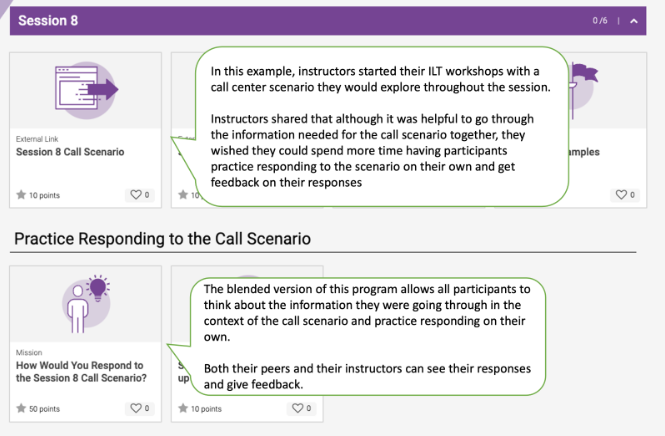
If you’ll be including live sessions, connect them to asynchronous work in a meaningful way
Are you breaking learners out into groups for activities during live sessions? Ask them to add that groupwork to the system where they’re going through content on their own, so they can refer to that activity, see others’ work on the same activity, and how it connects with subsequent material.
If learners are working on a project throughout the program, you can provide opportunities for them to get peer and instructor feedback along the way to help them develop their project. Then, ask them to present their work as a capstone during a live session.
It’s also key to give learners plenty of notice when the live sessions will occur so they can plan their calendars accordingly. They can’t participate if they can’t make it to the session.
Here’s an example of blended learning with live and instructor components:
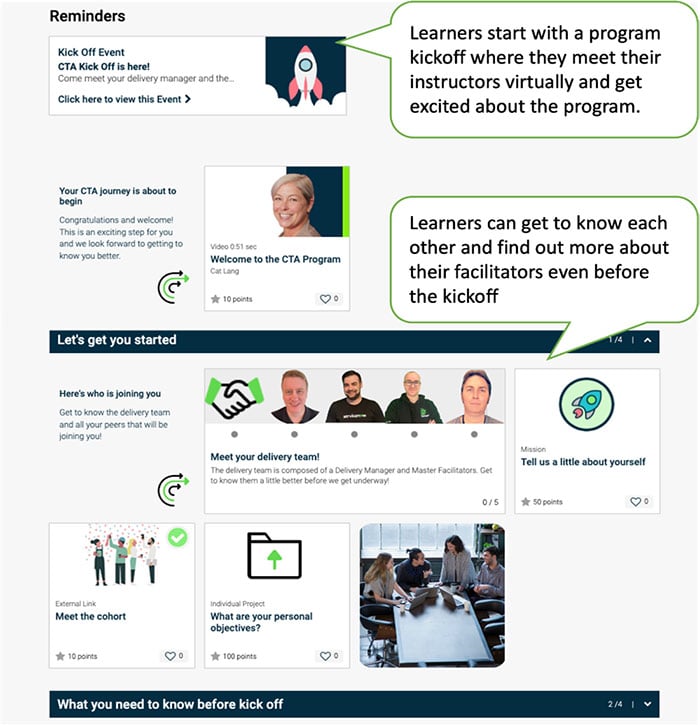
2. Create opportunities for learners to share, apply, and reflect
The most interesting, engaging, and transformative learning experiences are ones that involve active participation from learners—beyond just receiving information. This is why it’s crucial to create opportunities for your learners to share what they know, what their challenges and barriers are, and how they might take what they’re learning and apply it directly to their current work.
These could be in the form of polls, rich discussion forums with highly relevant prompts, real-world projects shared with peers, and other activities where they can share experiences related to the work they’re doing. Intrepid’s platform weaves these engaging features into a single collaborative learning experience. Here’s a more descriptive list to inspire your design ideas depending on your goals:
- Discussion Forums: Learners can engage with each other and learn together through real-world experiences with their peers.
- Workspaces: A space for learners to join small breakout groups and share insights, work on projects, and apply new concepts to solve real challenges at work.
- Missions and Projects: Learners use real-world challenges as opportunities to build new skills individually or as teams through relevant, experiential, on-the-job assignments. Learners can reflect on their experience and share with others.
- Peer Reviews: Learners can review and evaluate others’ final assignments and gain wisdom from their colleagues’ insights.
- Video Assignments: Learners practice new skills and receive AI-based feedback, as well as participate in group video projects to engage multiple learners and collaborate with their peers.
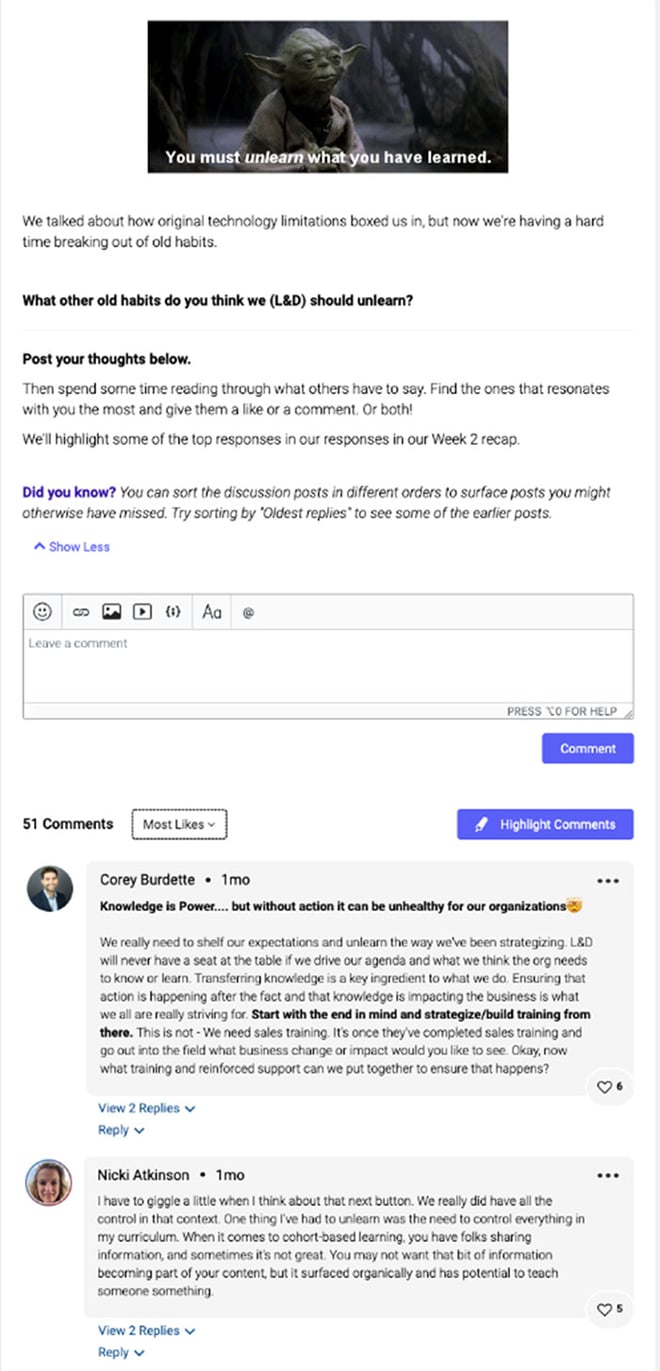
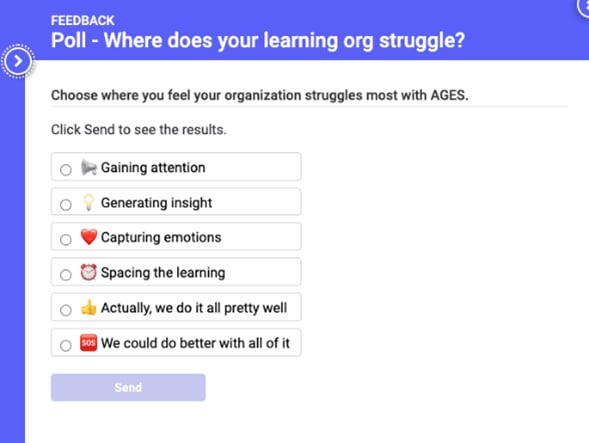
Psst, this also gives your instructors and moderators material to work with as they work to create a sense of community in your blended program.
3. Ask your instructors to be the guides on the side, not the sages on the stage
Speaking of instructors, they’re likely used to presenting information during instructor-led training or VILT sessions. While you may still have live sessions with learners in a blended training program, your instructors will have more impact on learner engagement not by being the guru with all the knowledge, but by being more like a gardener whose role is to grow a sense of community.
The goal is to help learners learn as much from each other on applying information to their everyday work, as they can from the content itself. An instructor can do this by:
- Responding to what learners share and ask
- Surfacing any emerging themes to address
- Collecting questions to expand upon
- Connecting learners with similar ideas, interests, or questions
- Curating any new content that is relevant or timely
- Acknowledging and spotlighting learner contributions
- Providing feedback like in the below examples
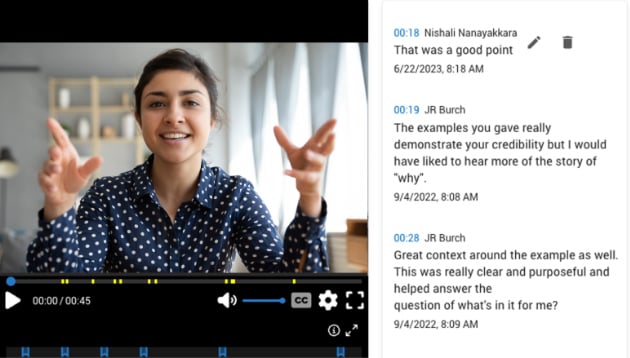
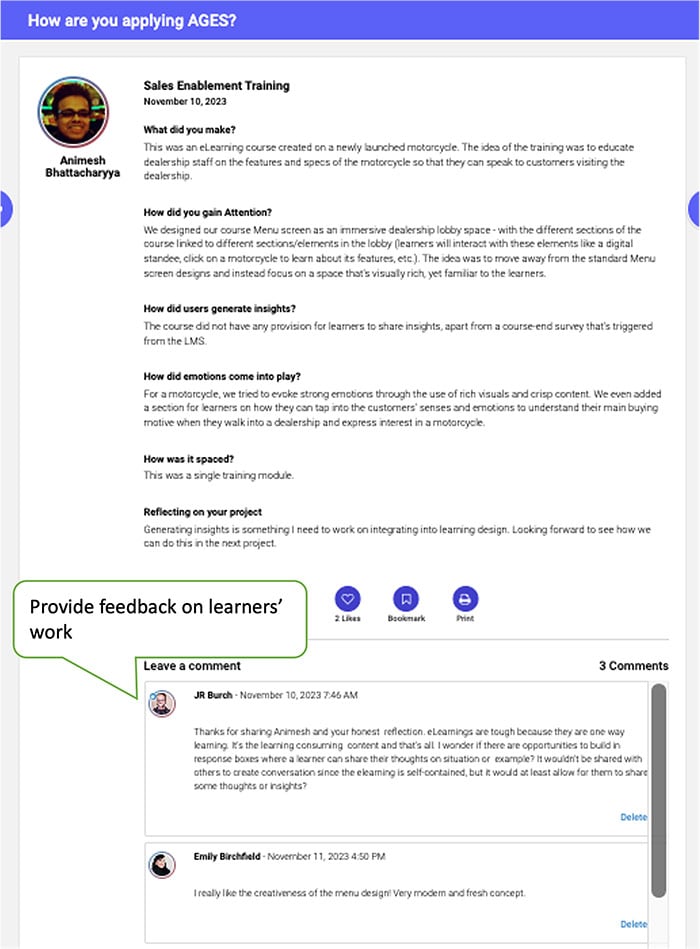
4. Plan your communications
Transitioning from instructor led training to a blended approach is just the first step. Ensuring consistent learner engagement throughout the program requires strategic and personalized communication. Once a program starts, you’ll need to keep your learners coming back. Here’s how:
- Create engaging welcome emails to get them into the site, introduces them to the platform, and highlights key features and expectations.

- Add gentle nudges when they’ve been inactive or need to complete an activity. A friendly reminder with a link into the program can rekindle their engagement.

- Encourage and highlight learner contributions so they feel acknowledged and celebrated. Public recognition goes a long way in fostering a sense of community and motivating continued participation.

Summary
While instructor-led training has served its purpose, it comes with limitations. By transitioning to a blended learning approach, you can merge ILT's strengths with the flexibility and engagement of online elements and create a learning program that's both engaging and impactful. Four tips for converting your instructor-led training to blended learning include:
- Design the experience with intention
- Encourage active participation through sharing and application
- Empower instructors to be guides
- Plan strategic communication
By implementing these steps, you'll create a learning journey that truly empowers your workforce and unlocks the full potential of blended learning. Ready to dive deeper? Chat with a learning advisor for more recommendations and to see how Intrepid can help support your success.
Frequently asked questions about instructor led training
What is instructor led training?
Instructor led training, or ILT, typically involves training facilitated by an instructor, either in a physical or virtual classroom setting, where knowledge is delivered through lectures, presentations, and group discussions.
How can I improve my instructor-led training?
Here are tips for improving instructor led training by transitioning to a blended learning approach:
- Use feedback from your instructor led training to inform your blended learning structure
- Include your instructors in the design process
- Connect asynchronous work to live sessions in a meaningful way
- Create opportunities for learners to share, apply, and reflect
- Ask instructors to guide and support, not lecture
- Plan your communications
Which is an advantage of blended learning over only instructor-led training?
Advantages of converting from instructor led training to blended learning can include: boosted engagement, enhanced accessibility and scalability, increased cost-efficiency, and more personalized learning.
What are the disadvantages of instructor-led training?
While instructor led training allows for immediate feedback and real-time interaction, it lacks flexibility and relies on a single instructor that can limit accessibility, personalized learning, scalability, and active learning opportunities.
false LOREM IPSUM TITLE



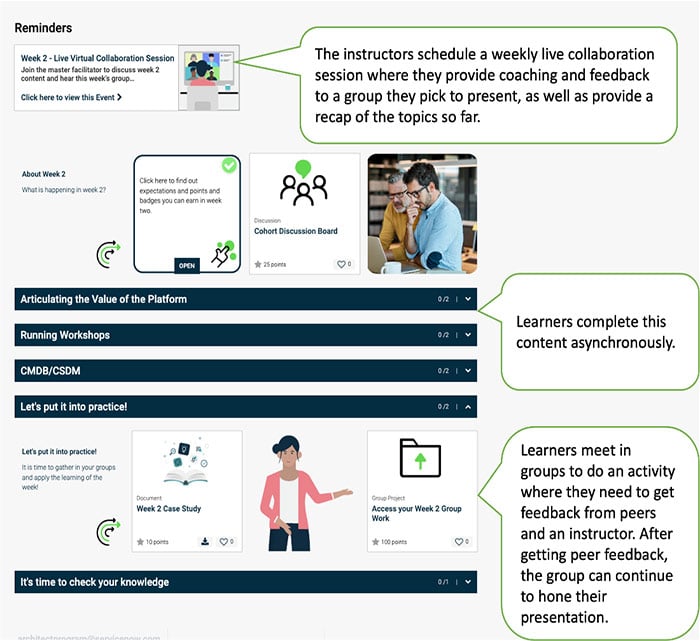

 Previous
Previous